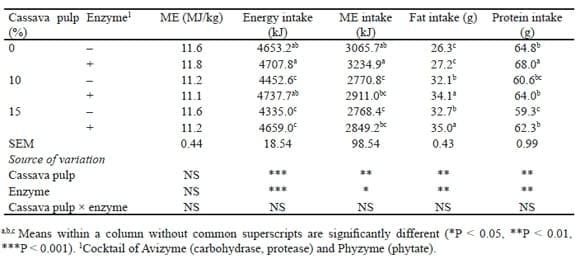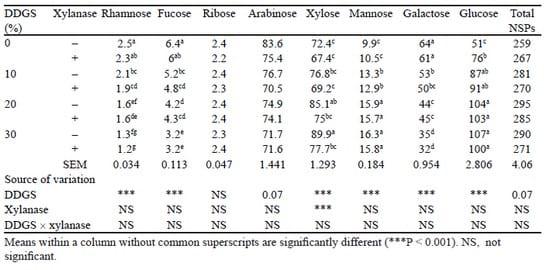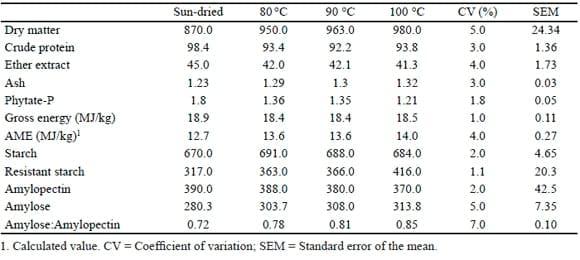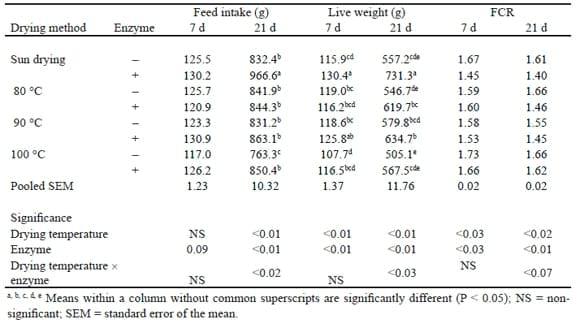Feed ingredients in poultry diets
Improving the nutritive value of alternative feed ingredients for poultry
Published: September 14, 2011
By: P.A. Iji, M.M. Bhuiyan, N. Chauynarong, M.R. Barekatain and A.P. Widodo (University of New England)
Summary
This paper discusses the use of alternative feed ingredients in poultry nutrition. The importance and limitations, particularly the presence of anti-nutritive factors, of such ingredients are highlighted. The results of a series of studies recently completed or ongoing at the University of New England, Australia, suggest that the nutritive value of such ingredients can be improved through supplementation with microbial enzymes. As it is likely that such ingredients will be increasingly used with enzyme supplementation and other treatments, it is important to identify the anti-nutritive factors in alternative ingredients and develop the best enzyme combinations for diets that contain these ingredients.
Introduction
The poultry industry relies on a few major ingredients for feed formulation. Cereal grains are the principal sources of energy in poultry diets, whereas grain legumes and oilseed cakes are the main sources of protein. Wheat, barley, triticale and sorghum are the key cereal grains and soybean meal, canola meal, peas, lupin and beans are important protein sources. The industry has always been inclined to use the cheapest ingredients to maximise profit (Batal, 2009). As such ingredients do not always support optimum productivity, they are included in small amounts or efforts are made to improve their nutritive value. Despite these limitations, the use of alternative feed ingredients is increasing due to a variety of factors. Conventional feed ingredients are more expensive and are not readily available to all producers at all locations. Adverse climatic conditions and the use of feed ingredients in the biofuel industry have stimulated the search for alternative feed ingredients for poultry. The biofuel industry generates by-products such as distillers'''''''''''''''' dried grains and solubles (DDGS), that not only need to be disposed of but are becoming core feed ingredients because of the shortage and cost of conventional ingredients. For example, it is estimated that 35% of the maize crop of the USA will be used for ethanol production in 2011. In Australia, most of the ethanol produced by the biofuel industry is derived from sugarcane, but two plants, one in New South Wales and one in Queensland, use grains for ethanol production. More plants are planned (King, 2009) and although the El-Nino phenomenon appears to have ended a drought cycle, the country usually experiences drought every 6–10 years, so that grain production will continue to be affected. In many grain-producing areas, the drought has given way to flooding.
All over the world, but more so in areas experiencing feed shortage, alternative ingredients are investigated with the aim of replacing all or some conventional ingredients. With alternative diets, poultry productivity is often poor due to deficiencies in nutrients such as amino acids and minerals, imbalances in energy to protein ratios (Dilger and Baker, 2008) or anti-nutritive factors such as non-starch polysaccharides (NSPs), polyphenols or phytic acid (Iji, 1999; Iji et al., 2004; Olukosi et al., 2010). There is insufficient data on the nutrient composition of many alternative ingredients. Producers strive to improve the quality of alternative diets through a variety of practices, including feed processing and supplementation with nutrients. The aim of this paper is to review the use of feed additives for unconventional diets to improve their quality, with particular reference to recent research at the University of New England.
Cassava and cassava by-products: a new energy source
The use of cassava roots and other parts of the plant as an animal feed is traditional in Africa and Asia (Chauynarong et al., 2009). Recently, cassava production began on a large scale in northern Queensland to support feedlots (Peter Cain, pers. comm.). There is a possibility that this industry could diversify into nonruminant feed production in the future. In Thailand, the third largest producer of cassava, almost all cassava is used for animal feed and starch production. The latter industry yields a fibrous by-product, cassava pulp, which has been used for feeding cattle and pigs. We tested this product as a replacement for maize in diets for layers and broiler chickens (Chauynarong, 2011) and established that 15% cassava pulp can be included in layer diets without detrimental effects on egg production and egg quality, except yolk colour, which was paler for diets containing cassava pulp. Supplementation with products with xylanase and phytase activities (Danisco Animal Nutrition, Marlborough, UK) enabled an increase in cassava pulp inclusion to 20% in diets for layers and maintained egg production at the same level as the maize control diet.
In another study, we measured metabolizable energy (ME), net energy of production (NEp) and heat production of broiler chickens raised on starter diets containing cassava pulp and microbial enzymes. The ME content of the diets and the intake of ME and protein were reduced by increasing levels of the by-product in the diet but were improved by the enzyme supplements (Table 1). NEp and heat production were reduced by cassava pulp but were increased by supplementation with microbial enzymes. The efficiency of utilization of ME for energy and fat retention was reduced by cassava pulp but the efficiency of utilization of ME for protein retention was increased. Enzyme supplementation had no effect on these values. Feed intake to 35 days of age was reduced (P < 0.05) by inclusion of 10% cassava pulp but feed intake recovered as inclusion level rose to 15%; it was not affected by microbial enzyme supplementation at either level.
Overall, there is scope for the use of cassava pulp in diets for layers and broiler chickens at low levels, but this would require supplementation with microbial enzymes and yolk pigments. It is likely that the Australian poultry industry will use more cassava chips and pellets in future and less cassava pulp.
Triticale for poultry
The University of New England has conducted research on triticale for several years (Scanlan, 2005; UNE, 2008).
Table 1. Metabolizable energy content of diets containing cassava pulp for poultry and intake of metabolizable energy (ME), fat and protein (as-fed basis).

A major limitation to increased exploitation of triticale for poultry feeding in Australia is a dearth of published data. The energy value of triticale was assessed as part of a larger project, the Premium Grains for Livestock program, which included a wide range of grains (Black et al., 2005). Ravindran et al. (2005) reported lower amino acid digestibility for triticale than for wheat and maize. In another study, Hughes and van Barneveld (2004) reported that pre-germination of triticale, wheat and sorghum did not improve the apparent ME (AME) of triticale, wheat or sorghum. Triticale holds promise as a replacement for wheat due to its tolerance of drought and poor soils. This advantage would be extended if the nutritive value of the crop were equal to or better than that of wheat. Most of the triticale varieties developed at the University of New England are higher in crude protein than wheat, ranging from 123.91 to 138.64 g/ kg DM. The in vitro digestibility of triticale starch and protein varies between 41.1% and 87.8%. A feeding experiment was concluded to define the AME of diets containing 72–75% triticale and the NEp and HP of broiler chickens raised on diets in which triticale completely replaced wheat (Table 2). The ME intake and NEp from 1 to 22 days were lower (P < 0.05) on the wheat-based diet than on the Bogong-, Jackie-, Tobrukand maize-based diets, and diets containing the other two varieties of triticale (Canobolas and Endeavour) did not differ from the wheat-based diet. Chickens fed triticale-based diets retained more (P < 0.05) energy in the form of protein and fat than those fed the wheatbased diet. These diets may promote protein accretion and growth on the one hand while increasing meat fat content on the other hand.
The results of the study show that the utilisation of energy in triticale is not poorer than that in conventional ingredients such as wheat and maize. This study also shows that energy deposition as protein is greater than energy deposition as fat for triticale-based diets. This may affect the quality of meat produced using such diets.
Sorghum distillers´ dried grains
DDGS will remain in the forefront of nutrition research for some time as the major cereal producers, particularly those in the USA, intensify efforts to reduce dependence on petroleum. Most research on DDGS has focussed on maize DDGS produced in North America. In Australia, most DDGS is derived from sorghum or wheat and has not been used to a large extent by poultry producers. We initiated a project aimed at improving the nutritive value of sorghum DDGS for poultry. In preliminary tests, six DDGS samples were obtained from the Shoalhaven Starches Plant in New South Wales to investigate variability between batches. The six samples were obtained on six different occasions. The DM content of the DDGS samples ranged from 890.5 to 931 g/kg. The highest gross energy content was 19.59 MJ/kg and the lowest gross energy content was 18.69 MJ/kg. Lipid content ranged from 79.5 to 100.1 g/kg with a coefficient of variation (CV) of 9%. Crude protein content was relatively high, between 287.1 and 310.4 g/kg (CV = 3%). Starch content ranged from 65.02 to 80.01 g/kg DM (CV = 8%). Most of the starch was digestible, as indicated by low resistantstarch content (12.8–18.5 g/kg). The average content of insoluble NSP in the six samples was 178 g/kg and the soluble and free sugar contents were 27.65 and 54.63 g/kg DM, respectively. The phytate content varied from 1.61 to 1.79 g/kg (CV = 5 %).
The samples generally contained appropriate amounts of essential amino acids and had a high content of threonine (10.1–11.4 g/kg). The content of the first limiting amino acid for poultry, lysine, was the most variable, with a range of 4.0–5.4 g/kg and a CV of 12%. Methionine content varied from 3.5 to 4.5 g/kg (CV = 10%).
We conducted two feeding trials in which microbial enzymes were supplemented. In the first experiment, 432 day-old male broiler chicks were used in a 4 × 2 factorial design. Four levels of DDGS inclusion (0, 100, 200 or 300 g/kg) with or without a xylanase enzyme (Ronozyme WX, 1000 fungal Xylanase units per gram, DSM, Heerlen, Netherlands) were fed for 21 days in starter diets and then from 21 days to 35 days of age in finisher diets. Compared with the control diet, feed intake was increased (P < 0.001) by DDGS during the first 3 weeks and during the entire period of the study. Body weight gain was not affected by DDGS or xylanase. Feed conversion ratio (FCR) deteriorated (P 0.05) as the level of DDGS increased during the first 3 weeks of feeding. Over that period, the effect of xylanase supplementation was not significant for inclusion of up to 200 g/kg DDGS. However, in birds fed 300 g/ kg DDGS, xylanase supplementation improved FCR (P < 0.05) over the starter period and over the entire feeding period with the result that birds fed this diet ended the study with body weights similar to those of other treatments but tended to consume less feed than birds fed the other diets. These results concur with those reported by Liu et al. (2011) for maize DDGS.
Table 2. Metabolisable energy (ME) content, ME intake, net energy (NE) of production and energy retained as protein and fat for broilers fed diets based on triticale (Bogong, Canobolas, Endeavour, Jackie, Tobruk), wheat or maize (as-is basis).

Protein digestibility declined as the level of DDGS increased. This could be responsible for the increase in feed intake as a result of DDGS inclusion. However, starch digestibility was not affected by enzyme supplementation or DDGS.
Analysis of total NSPs (Table 3) showed that increasing the level of DDGS to 30% reduced the concentrations of rhamnose and fucose in ileal digesta. The concentrations of arabinose, ribose and total NSP in ileal digesta were not affected by DDGS level, whereas levels of glucose and xylose in ileal digesta rose as DDGS level rose to 30%. Xylanase supplementation increased xylose concentration in the digesta, but only at the 30% DDGS level.
It can be concluded from this study that inclusion of up to 30% DDGS in broiler diets is feasible and that when combined with carbohydrases, xylanase in particular, productivity is similar to that for DDGS-free diets. Xylanase may depolymerise viscous xylans, and therefore reduce their detrimental effect on nutrient digestion. This is partly responsible for the observed increase in the concentration of free xylose in digesta. However, protein digestibility and growth were reduced when diets contained 20% or 30% DDGS with no enzyme supplementation.
High-moisture maize
More than 817 million tonnes of maize were produced worldwide in 2009, compared with 682 million tonnes of wheat (FAO, 2009). The production of maize is increasing in non-tropical areas of the world, in southern Europe and parts of temperate South America. This necessitates early harvest at a relatively high moisture content and artificial drying. Artificial drying of high-moisture grain is fraught with problems. The starch quality, particularly the ratio of amylopectin to amylose, may be affected, reducing the nutritive value of the grain (Bhuiyan et al., 2010a, b). Amylopectin is the most digestible starch fraction. Recently, we investigated changes in the physical quality and nutrient composition of high-moisture maize grain subjected to artificial drying. This was followed by a feeding trial in which microbial enzymes (carbohydrase, protease and phytase) were included in the diet.
Maize cobs with the grain attached were harvested at relatively high moisture content (23%) from in northern New South Wales and dried in the sun or in a forced-draught oven at 80, 90 or 100 °C for 24 hours. The in vitro digestibility of DM, starch and crude protein were determined according to the method of Babinszky (1990) and the structure of grain was assessed using electron microscopy and nuclear magnetic resonance techniques (Bhuiyan et al., 2010a). The results are shown in Table 4. The scanning electron microscope showed some shrinkage of starch granules as a consequence of drying temperature. The in vitro digestibility of DM was improved by artificial drying but starch digestibility was reduced.
The effects of feeding diets containing sundried or artificially dried high-moisture maize grain supplemented with microbial enzymes on growth performance, visceral organ mass, tissue protein content, enzyme activity and gut development were investigated in a broiler growth trial (Bhuiyan et al., 2010b). Feed intake up to 21 days of age was decreased by oven drying whereas microbial enzymes increased feed intake compared with non-enzyme diets (881.1 vs 817.2 g) (Table 5). Feed intake was highest for sundried grain. There was no effect of drying temperature or enzymes on feed intake at 7 days of age.
Table 3. The effect of graded levels of distillers´ dried grains and solubles (DDGS) and xylanase on the total nonstarch polysaccharide composition of ileal digesta (g/kg) in 21-day-old birds.

Table 3. The effect of graded levels of distillers´ dried grains and solubles (DDGS) and xylanase on the total nonstarch polysaccharide composition of ileal digesta (g/kg) in 21-day-old birds.

Table 4. Composition (g/kg) of maize resulting from sun drying or artificial drying at various temperatures.

Table 5. Feed intake, live weight and feed conversion ratio (FCR) of broiler chickens at 7 and 21 days of age for diets based on maize that was sundried or dried artificially at various temperatures with or without enzymes.

Up to 21 days of age, body weight decreased as grain drying temperature increased and supplementation with enzymes improved weight only for diets containing sundried grains and grains dried at 90 °C. Body weight was higher (P < 0.01) for the enzyme-supplemented diets than for diets that did not contain enzymes (638 vs 547 g). FCR at this age improved as grain drying temperature increased and was improved by enzyme supplementation (1.48 vs 1.62). There was an increase in the relative weight of the small intestine and liver with an increase in grain drying temperature at 21 days of age enzyme supplementation did not change the relative weights of these organs. Grain drying treatment, but not enzyme supplementation, increased the activities of alkaline phosphatase (on day 7) and maltase and sucrase (on day 7 and day 21, respectively).
The ileal digestibilities of gross energy, protein and starch were not changed by grain drying temperature or enzyme supplementation. This contradicts the report of Iji et al. (2004) in which similar enzymes improved the body weight of broiler chicks fed diets based on sundried maize. The enzymes were also more effective with sundried maize than with artificially dried maize. No clear reason could be adduced for this disparity, but changes in starch quality as a result of heating could have reduced the overall quality of the grain and its response to enzyme supplementation.
The concentrations of formic and acetic acids in the ileum and propionic and valeric acids in the caeca were significantly increased by an increase in grain drying temperature but there was no effect of enzyme supplementation on the concentrations of these acids. The populations of lactic acid bacteria and lactobacilli in ileal digesta were decreased by enzyme supplementation but were not affected by drying temperature. The total anaerobic bacteria count in caecal digesta was increased by microbial enzymes (8.1 vs 7.8 log10 colony-forming units per gram of digesta). The number of lactic acid bacteria was increased by increased grain drying temperature. The response of microbial populations to changes in the quality of grain in the diet has not been studied previously. Concentrations of short-chain fatty acids in the upper small intestine of broiler chickens were increased by diets high in low-AME wheat (Choct et al., 1999). This may be indicative of an increase in microbial populations responsible for the fermentation of fibre.
In the current study, diets based on sundried maize or maize dried at 90 °C gave better responses than maize that was artificially dried at other temperatures. There was a positive response to microbial enzymes.
Conclusion
The increased use of alternative ingredients has increased the demand for microbial enzyme supplements. The studies presented in this paper illustrate how responses to microbial enzyme supplements differ and suggest that producers should to choose supplements according to dietary treatment.
References
Babinszky L, van der Meer JM, Boer H, den Hartog LA (1990) An in-vitro method for prediction of the digestible crude protein content in pig feeds. Journal of the Science of Food and Agriculture 50, 173-178.
Batal AB (2009) How much DDGS for poultry? Feed International 30, 18-19.
Bhuiyan MM, Islam AFM, Iji PA (2010a) Variation in nutrient composition and structure of high-moisture maize dried at different temperatures. South African Journal of Animal Science 40, 190-197.
Bhuiyan MM, Islam AFM, Iji PA (2010b) Response of broiler chickens to diets containing artificially dried high-moisture maize supplemented with microbial enzymes. South African Journal of Animal Science 40, 348-362.
Chauynarong N (2011) Evaluation of cassava pulp as a substitute for maize in poultry diets. PhD thesis, University of New England.
Chauynarong N, Elangovan AV, Iji PA (2009) The potential of cassava products in diets for poultry. World''''''''''''''''s Poultry Science Journal 65, 23-35.
Choct M, Hughes RJ, Bedford MR (1999) Effects of a xylanase on individual bird variation, starch digestion throughout the intestine, and ileal and caecal volatile fatty acid production in chickens fed wheat. British Poultry Science 40, 419-422.
Batal AB (2009) How much DDGS for poultry? Feed International 30, 18-19.
Bhuiyan MM, Islam AFM, Iji PA (2010a) Variation in nutrient composition and structure of high-moisture maize dried at different temperatures. South African Journal of Animal Science 40, 190-197.
Bhuiyan MM, Islam AFM, Iji PA (2010b) Response of broiler chickens to diets containing artificially dried high-moisture maize supplemented with microbial enzymes. South African Journal of Animal Science 40, 348-362.
Chauynarong N (2011) Evaluation of cassava pulp as a substitute for maize in poultry diets. PhD thesis, University of New England.
Chauynarong N, Elangovan AV, Iji PA (2009) The potential of cassava products in diets for poultry. World''''''''''''''''s Poultry Science Journal 65, 23-35.
Choct M, Hughes RJ, Bedford MR (1999) Effects of a xylanase on individual bird variation, starch digestion throughout the intestine, and ileal and caecal volatile fatty acid production in chickens fed wheat. British Poultry Science 40, 419-422.
Dilger RN, Baker DH (2008) Cyst(e)ine imbalance and its effect on methionine precursor utilization in chicks. Journal of Animal Science 86, 1832-1840.
Driscoll CJ, McLean MA, Napier KV, Johnson RJ (1983) Triticale breeding, interstate trials and quality evaluation. Proceedings of the Australian Plant Breeding Conference, Adelaide, South Australia, pp.112-113. FAO (2009) Crop production indices. FAO, Rome, Italy.
Iji PA (1999) The impact of cereal anti-nutritive factors on intestinal development and function in broiler chickens. World''''''''''''''''s Poultry Science Journal 55, 375- 387.
Iji PA, Khumalo K, Slippers S, Gous, RM (2004) Intestinal function and body growth of broiler chickens on maize-based diets supplemented with mimosa tannins and a microbial enzyme. Journal of the Science of Food and Agriculture 84, 1451- 1458.
Iji PA, Khumalo K, Slippers S, Gous RM (2003) Intestinal function and body growth of broiler chickens on diets based on maize dried at different temperatures and supplemented with a microbial enzyme. Reproduction, Nutrition, Development
43, 77-90.
King RH (2009) Are co-products and algae costeffective alternative nutrient sources for Australian livestock production? Recent Advances in Animal Nutrition - Australia 17, 1-6.
Liu N, Ru YJ, Tang DF, Xu TS, Partridge GG (2011) Effects of corn distillers dried grains with solubles and xylanase on growth performance and digestibility of diet components in broilers. Animal Feed Science and Technology 163, 260-266.
Olukosi OA, Cowieson AJ, Adeola O (2010) Broiler responses to supplementation of phytase and admixture of carbohydrases and protease in maize-soyabean meal diets with or without maize distillers'''''''''''''''' dried grain with solubles. British Poultry Science 51, 434-443.
Scanlan J (2005) More than 100 varieties of triticale on display at field day. http://www.une.edu.au/news/ archives/000395html; retrieved 28 November 2005.
UNE (2008) New triticales increase potential to meet demand for feed grains. University of New England 2008 Research Highlights, p. 39.
This article was originally published in Recent Advances in Animal Nutrition- Australia Volume 18 (115-120). Engormix.com thanks the authors and the organizing committe for this huge contribution.
Driscoll CJ, McLean MA, Napier KV, Johnson RJ (1983) Triticale breeding, interstate trials and quality evaluation. Proceedings of the Australian Plant Breeding Conference, Adelaide, South Australia, pp.112-113. FAO (2009) Crop production indices. FAO, Rome, Italy.
Iji PA (1999) The impact of cereal anti-nutritive factors on intestinal development and function in broiler chickens. World''''''''''''''''s Poultry Science Journal 55, 375- 387.
Iji PA, Khumalo K, Slippers S, Gous, RM (2004) Intestinal function and body growth of broiler chickens on maize-based diets supplemented with mimosa tannins and a microbial enzyme. Journal of the Science of Food and Agriculture 84, 1451- 1458.
Iji PA, Khumalo K, Slippers S, Gous RM (2003) Intestinal function and body growth of broiler chickens on diets based on maize dried at different temperatures and supplemented with a microbial enzyme. Reproduction, Nutrition, Development
43, 77-90.
King RH (2009) Are co-products and algae costeffective alternative nutrient sources for Australian livestock production? Recent Advances in Animal Nutrition - Australia 17, 1-6.
Liu N, Ru YJ, Tang DF, Xu TS, Partridge GG (2011) Effects of corn distillers dried grains with solubles and xylanase on growth performance and digestibility of diet components in broilers. Animal Feed Science and Technology 163, 260-266.
Olukosi OA, Cowieson AJ, Adeola O (2010) Broiler responses to supplementation of phytase and admixture of carbohydrases and protease in maize-soyabean meal diets with or without maize distillers'''''''''''''''' dried grain with solubles. British Poultry Science 51, 434-443.
Scanlan J (2005) More than 100 varieties of triticale on display at field day. http://www.une.edu.au/news/ archives/000395html; retrieved 28 November 2005.
UNE (2008) New triticales increase potential to meet demand for feed grains. University of New England 2008 Research Highlights, p. 39.
This article was originally published in Recent Advances in Animal Nutrition- Australia Volume 18 (115-120). Engormix.com thanks the authors and the organizing committe for this huge contribution.
Related topics:
Authors:


Recommend
Comment
Share
Recommend
Reply

24 de marzo de 2012
Prof Paul Please send me your email I want to contact you to exchange ideas on animal nutrition in the tropics
my email is: joaquinp17@gmail.com
Recommend
Reply

23 de marzo de 2012
Hello Tijani: Not at the moment. There is a postdoc already working on DDGS.
Paul
Recommend
Reply

4 de octubre de 2011
Thanks, Dr Adejoro, for providing Prof Makinde's contact details. I will mention your name when I contact him.
Cheers.
Paul
Recommend
Reply
Soavet
2 de octubre de 2011
Prof. Diran Makinde
Director, AU-NEPAD Agency African Biosafety Network of Expertise
E-mail: diran.makinde@nepadbiosafety.net
Website: www.nepadbiosafety.net
PROF Iji you may link prof Makinde on this address and reference Dr ADEJORO
Recommend
Reply

25 de septiembre de 2011
Professor Paul a greeting from the Dominican Republic I was a professor of ISA university, we experimented with many alternative ingredients and added enzymes and enzymatic cocktails, we evaluated forrageras legumes, wheat bran and rice bran, molasses, cassava flour and others.
When determining the cost-benefit ratio compared with soybean meal - corn diet.
We conclude that the alternative ingredients and byproducts and can be included without problems up to a maximum of 10 percent.
Only positive results obtained using phytase.
In the future can be obtained enzymes that are truly effective and to maximize the level of inclusion of alternative ingredients.
Recommend
Reply

24 de septiembre de 2011
I agree with Joaquin; alternative ingredients have a lot of limitations but we should ot forget that even the conventional diets have their limitations too. You cannot include wheat or barley in diets without microbial enzyme supplementation or soybean without heat treatment. Biotechnical companies are working hard to develop suitable enzymes for inclusion in diets containing alternative ingredients. Part of our focus has been to develop diets containing these alternative ingredients, and then see which additives are most suitable for them.
Thanks for your comments, Dr Jaydip.
Cheers.
Paul
Recommend
Reply


Enhancing Egg Production: Key Factors Influencing Chicken Health and Yield
Suggested link

22 de septiembre de 2011
The topic is interesting alternative ingredients, but there is no alternative ingredients that produce the same results zootechnical as those obtained a diet of soybean meal - corn, we can enumerate amounts of by-products and alternative ingredients such as: molasses, cane siro, bran rice, dry distillers grains (DDGS) from corn and sorghum, palm oil cake, sunflower cake, bakery flour, meat and bone meal, poultry by-products, ect.
The big problem is:
1-The availability.
2-Quality.
3-Variability in nutrient intake.
4-High in fiber.
5-High in NSP.
6-High in anti-nutritional substances.
7-High in mycotoxins.
These and other factors reduce the production performance of animals.
Recommend
Reply
Univ. degli Studi di Bari Aldo Moro
18 de septiembre de 2011
Very interesting and relevant article, my compliments to Prof Iji and others.
Recommend
Reply

18 de septiembre de 2011
Ibrahim: I believe that every region has alternative ingredients. I do recognise the limitations in the Middle-East, as I did my first degree in the relatively aride area of north-east Nigeria. That region had what was known as the 60-day beans, a very fast maturing plant that was very high-yielding. Even Dates have some nutritional value. Can they be improved in any way?
Cheers.
Paul
Recommend
Reply

Would you like to discuss another topic? Create a new post to engage with experts in the community.
Featured users in Poultry Industry

Shivaram Rao
Pilgrim´s
PhD Director Principal de Nutrición y Servicios Técnicos de Pilgrim’s Pride Corporation
United States
United States

Nelson Ward
dsm-Firmenich
Manager, New Business Development at DSM Nutritional Products Inc.
United States
United States










